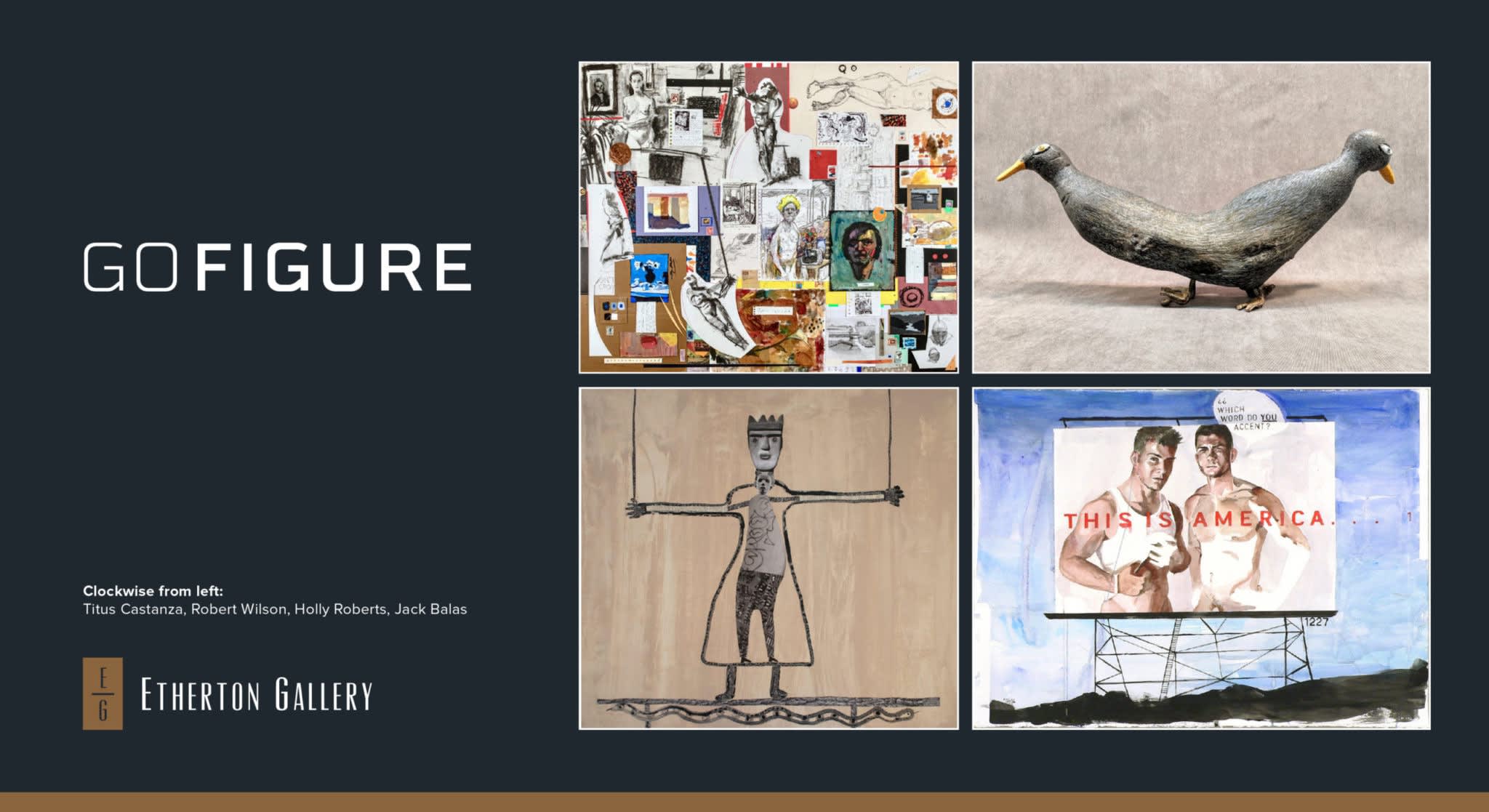
Etherton Gallery is pleased to present Go Figure, featuring recent paintings by Jack Balas, collages by Titus Castanza and mixed media by Holly Roberts, with sculpture by Robert Wilson. The exhibition showcases some of the most exciting artists working in the Southwest today. They use the figure to narrate personal stories using painting, collages, and mixed media -- that upon reflection are also our own -- addressing universal themes that acknowledge the questioning, wry, often uncomfortable compartmentalized sum of ourselves. They physically or intellectually alter their completed works and remake them to create something new. In the process their personal narratives transform into something that speaks to our shared human experience. An installation of paintings from the series Cataloguing Infinity by Benjamin M Johnson, will be on display in the gallery pop-up. A closing reception for Go Figure is planned; date to be announced. The show runs through May 30th.
Titus Castanza’s work is about cutting up the past and suturing it back together. He cuts up his own completed paintings and drawings and uses them as the foundation of the new collages on display in Go Figure. He reassembles the scraps combining them with found materials from his studio, such as sketchbook drawings, doodles on napkins, Rolo™ candy wrappers, stamps, letters from friends, thread, mat board, screws, and piano sheet music he’s composed. Through this process he creates a new work in an entirely new context. The result is a new narrative that combines a past unmoored from time with comour daily lives, to create something a new visual experience that more closely resembles our shared human journey.
Holly Roberts shares a similar interest in engaging with the past to create something new, also reworking found or existing materials. She begins by creating an abstract painting using acrylic paint on panel, which becomes the foundation of the image. She then selects one or more photographs from an archive of her own original photographs. Walking a fine line between control and intuition, she cuts the photographs, and adheres them to the surface of her painting. She also uses other materials we encounter in daily life -- such as newsprint, paintings on paper, dictionary pages. In the new image animals, people or people as animals become the vehicles that portray complicated relationships -- something we all experience in life.
Painter Jack Balas began spending winters in Tucson in 2003-4 after a one year appointment as a lecturer in the School of Art at the University of Arizona. His figurative paintings combine traditional materials like oil, acrylic and watercolor paints, ink and pencil, enamel -- but in non-traditional ways. For example, he annotates his work with text and other images and in 2002, he began numbering his paintings sequentially -- to keep track of time, but also in recognition of the fact that experience (including the artistic process) is cumulative and overlapping. Many of his paintings demonstrate the influence of his experience in Tucson, addressing the desert, the Latinx community, and current debates about immigration, and The Wall. LA PARED (THE WALL), NOGALES is the centerpiece of the show The paintings include boxers and texts in both English and Spanish about the day that Balas walked across the border in Nogales without a passport. Other works like THIS IS AMERICA (WHICH WORD DO YOU ACCENT?) address gay visibility.
For over four decades, Robert Wilson has enjoyed a distinguished medical career. As a student he studied with some of the world’s great animal scientists and ecologists like Jane Goodall and Paul Ehrlich, which left a lasting impression. Wilson’s interest in the evolution of and the interconnection among species -- then and now – have compelled him to make sculpture that explores the essence of an animal’s being -- how they look, move and behave. His reductive, organic figures, made with found or salvaged materials begin with a single body part -- a wolf head carved from wood or a bird foot welded from scrap steel. He continues working instinctively until the work is completed, or “becomes itself” -- taking on a sense of its animalistic individuality.
Like Castanza, Roberts and Wilson, the foundation of Benjamin M Johnson’s work is an engagement with the past. The paintings from the series Cataloging Infinity function as visual poems about the human experience, drawing from disparate intellectual, art historical movements and techniques. Johnson understands the analogue materiality of art as a “tether to our physical human-ness,” and a “bridge between the past and the future,” a universal bond that ties us together in the context of the digital age.




